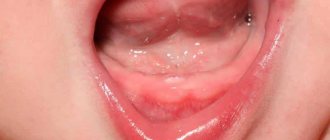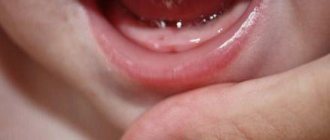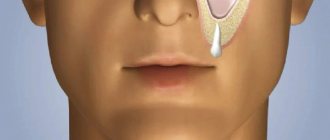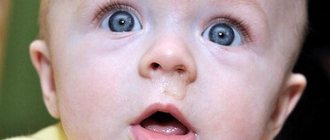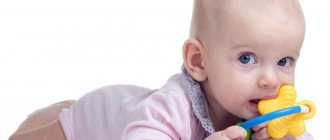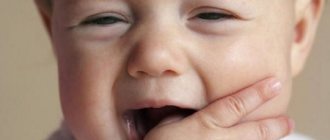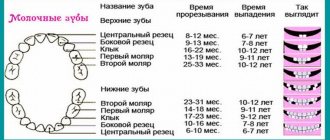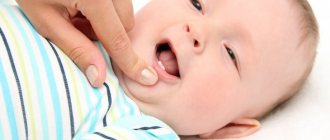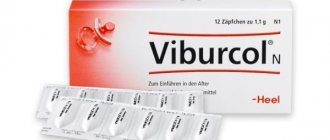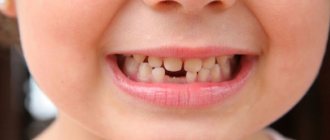Is a rash on the child’s body typical in this situation?
The child's excitability is explained by the first teeth cutting into the mouth, which causes discomfort to the baby and is accompanied by pain and itching in the mouth. Sleep is disturbed, the child becomes whiny, often for no apparent reason. A rash is a kind of response of the child’s body to external and internal irritants. The reaction can occur when a child comes into contact with previously unfamiliar things/objects, dust, chemicals, and infection is often the cause of the illness.
Localization
There may be different manifestations of irritation on the baby’s body during the eruption of baby teeth; most often, the rash appears on the neck, then moves down to the abdomen, and from the abdomen spreads to the child’s arms and legs. The rash itself can be of several types, may be accompanied by severe itching, or may be dry. The rash, or rather the nature of its appearance, will surprise not only young parents, but also doctors. Its appearance is influenced by many factors; each case of the appearance of a rash must be considered individually, with the reasons being clarified.
Rash on the body
In this case, the rash manifests itself sequentially, visually, and at first glance it is invisible, it may be rough to the touch. This form of rash does not appear for some reasons, here are some of them:
- This is the baby’s body’s reaction to various stresses, one of them is the process of teething. Due to the presence of pain, the child’s nervous system is heavily loaded, and this is what causes the rash on the baby’s body.
- The reason may also be a lack of essential substances in the body, one of them is calcium. This is possible when a number of teeth erupt at the same time. During this period, the baby’s body requires the necessary calcium to form new strong teeth. Its deficiency results in a rash on the body.
Places of rashes
Most often, when the first teeth appear in children, a rash appears on the following areas of the body:
- A rash on the lower part of the chin is a sure sign of the body’s reaction to the appearance of teeth. This is the most common and characteristic symptom indicating skin irritation with saliva. Less commonly, reddening of the skin on the face is caused by parents’ failure to observe basic hygiene rules when caring for children or the use of low-quality household chemicals.
- A rash on the neck can also be a signal indicating the body's reaction to the appearance of teeth. Moreover, this localization of skin lesions is often accompanied by redness of the lower part of the baby’s face.
- A rash on the body is much less likely to be a consequence of teeth growth. In most cases, it is provoked by other factors, such as an infection or an allergic reaction in the baby’s body to a new food product.
This symptom is largely provoked by stress in the body, which in medicine is often called a “cytokine explosion.”
Remember! It is important not only to identify the rash itself, but also to determine its intensity, the presence of itching, density and other features that may indicate the root cause of the disease.
Teething and facial rash
During the teething process, the baby develops a rash. The first place of its appearance is considered to be the neck, then it tends to spread around, moving to the stomach, then to the arms and legs of the child, and it also goes up to the face. In this case, it is very difficult to cure a rash that appears on the face on your own, due to the fact that you need to know exactly the reason for its appearance. And using various ointments for other purposes than their intended purpose will only aggravate the situation, because the ointments will only irritate the child’s delicate skin.
Therefore, for effective treatment, it is recommended to conduct a comprehensive examination of the child, accurately determine the root cause of the disease during the eruption of the first teeth, and only then begin treatment.
Often such a rash appears due to the fault of inexperienced parents who do not always comply with the prescribed hygiene standards for the baby, use low-quality baby shampoos/soaps to bathe the child, or the child simply develops an allergy. The process of the appearance of a rash is very unpleasant and irritating, and often progresses due to the weakened immunity of the baby during teething. It is all this that gives such an unexpected result for parents.
Teething in children
In what order do children cut teeth? As a rule, this is the following order of growth of baby teeth:
- First two lower central incisors – 6-8 months
- First two upper central incisors – about 8 months
- First two upper lateral incisors – 8-12 months
- First two lower lateral incisors – 10-12 months
- First four chewing teeth – 14-20 months
- First four canines – 18-24 months
- Second four chewing teeth – 2-3 years
The appearance of an itchy rash in the child's neck
A rash that appears during the baby's teething is always accompanied by fever and irritability for no apparent reason. In this case, experts recommend bathing the child in herbal-based baths (queen, celandine, chamomile). After taking a bath, the baby should be wiped well, and the reddened areas should be lubricated with a special medicinal cream/ointment. In this case, doctors often prescribe baby creams or finistil. Ointments containing panthenol show a high degree of effectiveness.
Air baths help very well. They are effective in treating various skin rashes.
The use of soft clothing is not recommended, as this may further irritate the baby's delicate skin.
Regardless of the type of rash on the baby’s skin, parents should always consult with a specialist before starting treatment, who will prescribe a comprehensive examination, determine the cause of the disease, and prescribe the necessary medications. Only then can you begin to carry out a course of rehabilitation.
A recently born baby goes through a period of adaptation to the new world, and the appearance of rashes on its body should not be regarded as something unusual. This is simply the body's reaction to the appearance of external stimuli. And the rash itself appears not only due to the eruption of the first milk teeth, but can also be provoked by a number of other factors that occur simultaneously with the appearance of teeth.
What can cause a rash during teething?
Teething is only a factor that enhances the body’s response to external stimuli. It increases susceptibility to pathogens. What could be the cause of the rash? According to Dr. Komarovsky, rashes can be caused by an infection, an allergic reaction, or skin irritation.
READ ALSO: Lipoma (fat): reasons for how to get rid of wen on the body, face, head, back
Allergens: products, care products
Allergies usually appear as red spots or pimples. They can be localized in different parts: directly at the point of contact with the allergen or throughout the body. The rash is often accompanied by itching, burning, and irritation. The baby scratches allergic spots until they bleed.
Due to the fact that the body is in a stressful state during the teething period, the immune system reacts even to familiar irritants, and the introduction of new foods can cause an intensification of the reaction. What are the most common allergies to:
- new food products that the mother feeds the baby;
- detergents – washing powder, fabric softener;
- care products – baby shampoo, cream, powder;
- animals;
- plants.
When eating new food, pimples and spots may appear directly in the mouth - on the gums, tongue, palate, and inner surface of the cheeks. This disease is called allergic stomatitis.
What to do if allergic reactions intensify during the growth of baby teeth? The first step is to eliminate exposure to the allergen. The child needs to be put on a diet, excluding foods that can cause allergies, such as strawberries, melon, citrus fruits. You also need to change care products and detergents to hypoallergenic ones.
Infectious agents: bacteria, viruses, fungi
During the eruption of baby teeth, immunity decreases, and the child’s body becomes vulnerable to infection. Infectious diseases that manifest themselves as rashes on the body:
- Thrush is a fungal disease caused by fungi of the genus Candida. This is a conditionally pathogenic microflora that is normally present in the body and begins to multiply during a period of decreased immunity. A baby can become infected with thrush during childbirth, breastfeeding, due to dirty bottles and nipples, if the mother herself is sick with candidiasis. The disease manifests itself as rashes in the oral cavity and in the corners of the mouth. The mucous membrane becomes covered with white spots that look like the remains of cottage cheese or milk. In the advanced stage, bleeding ulcers form under a white film.
- Rubella is an infectious disease caused by the Rubella virus. After an incubation period of 15–20 days, red spots appear on the child’s body. Most often they are localized on the face, buttocks and lower back. Usually there are no complications after rubella, children tolerate it relatively easily.
- Measles is a dangerous viral disease caused by the RNA virus “morbillivirus”. Despite the fact that the rash is similar in appearance to rubella rashes, this disease is accompanied by high fever up to 40°C, cough and headache. When teething, the temperature also rises, but it is not as high, so if a rash with intense heat appears, you should immediately consult a doctor. Measles can cause serious complications and even death.
- Chickenpox is a disease caused by the herpes virus type 3. With chickenpox, blisters filled with a yellowish liquid appear on the body. In children, the disease is relatively mild, there is rarely a fever, and there are not as many rashes as in adults.
READ ALSO: Rash on the crook of a child’s arm: photo, itches, causes and what to do
Skin irritation due to saliva
Teething rash can be a result of excessive salivation. During this period, increased salivation occurs. Saliva has a bactericidal effect, it softens irritation, which is why it is actively secreted during the period when teeth are being cut.
In children under 1 year of age, the swallowing reflex is poorly developed. They cannot cope with the amount of saliva that forms, so it flows down the chin, neck, and chest. The skin around the mouth and below is constantly wet. If you do not treat it with creams and do not wipe off the saliva in a timely manner, then irritation appears on the baby’s chin. The skin peels, cracks, and small pimples appear on it. You can see what a rash due to irritation looks like in the photo.
Results
For each of the above reasons, a rash may appear all over the baby’s body, but the very cause of redness of the skin is often difficult to detect at first glance. It is worth determining whether the rash on the baby’s body is associated with the cause of the cutting of the first teeth, or whether it is a consequence of the impact of the above reasons on the baby’s fragile body. If a rash is detected, parents should consult a doctor, undergo all tests, identify the root cause of the redness and immediately begin treatment.
Share the article on social media. networks:
